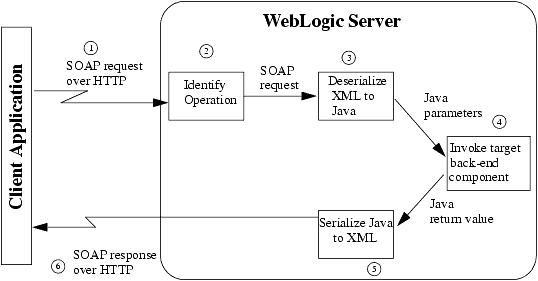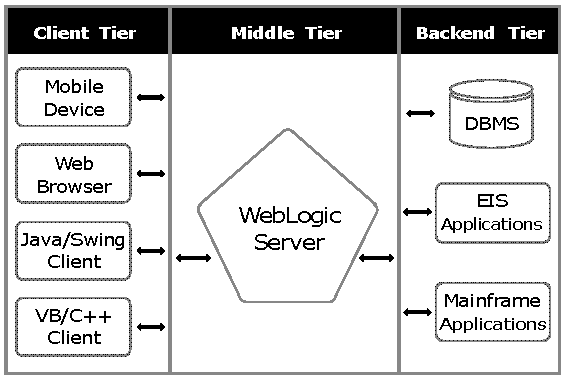Introduction
You develop WebLogic Server architecture, by using standard J2EE components, such as stateless session EJBs, and Java classes. Because WebLogic Web Services are based on the J2EE platform, they automatically inherit all the standard J2EE benefits, such as a simple and familiar component-based development model, scalability, support for transactions, life-cycle management, easy access to existing enterprise systems through the use of J2EE APIs (such as JDBC and JTA), and a simple and unified security model.
A single WebLogic Web Service consists of one or more operations; you can implement each operation using different back-end components and SOAP message handlers. For example, an operation might be implemented with a single method of a stateless session EJB or with a combination of SOAP message handlers and a method of a stateless session EJB.
The below describes the architecture of a WebLogic Web Service operation that is implemented with only a back-end component, such as a method of a stateless session EJB.

Prerequisites for learning weblogic
· Our real-time professionals help you to learn any new technology in ease manner.
· All attendees should have a basic knowledge of System Administrative background.
· Familiarity with installing and configuring software on a Windows platform is essential.
WebLogic Server is an application server: a platform for developing and deploying multitier distributed enterprise applications. WebLogic Server centralizes application services such as Web server functionality, business components, and access to backend enterprise systems. It uses technologies such as caching and connection pooling to improve resource use and application performance. WebLogic Server also provides enterprise-level security and powerful administration facilities.
WebLogic Server operates in the middle tier of a multitier architecture. A multitier architecture determines where the software components that make up a computing system are executed in relation to each other and to the hardware, network, and users. Choosing the best location for each software component lets you develop applications faster; eases deployment and administration; and provides greater control over performance, utilization, security, scalability, and reliability.
WebLogic Server implements J2EE, the Java Enterprise standard. Java is a network-savvy, object-oriented programming language, and J2EE includes component technologies for developing distributed objects. This functionality adds a second dimension to the WebLogic Server application architecture—a layering of application logic, with each layer selectively deployed among WebLogic Server J2EE technologies.
Software Component Tiers
The software components of a multitier architecture consist of three tiers:
The client tier contains programs executed by users, including Web browsers and network-capable application programs. These programs can be written in virtually any programming language.
The middle tier contains WebLogic Server and other servers that are addressed directly by clients, such as existing Web servers or proxy servers.
The backend tier contains enterprise resources, such as database systems, mainframe and legacy applications, and packaged enterprise resource planning (ERP) applications.
Client applications access WebLogic Server directly, or through another Web server or proxy server. WebLogic Server generally connects with backend services on behalf of clients. However, clients may directly access backend services using a multitier JDBC driver.

Client Tier Components
WebLogic Server clients use standard interfaces to access WebLogic Server services. WebLogic Server has complete Web server functionality, so a Web browser can request pages from WebLogic Server using the Web's standard HTTP protocol. WebLogic Server servlets and JavaServer Pages (JSPs) produce the dynamic, personalized Web pages required for advanced e-commerce Web applications.
Client programs written in Java may include highly interactive graphical user interfaces built with Java Swing classes. They can also access WebLogic Server services using standard J2EE APIs.
All these services are also available to Web browser clients by deploying servlets and JSP pages in WebLogic Server.
This version of WebLogic Server supports a true J2EE application client. In previous versions, a WebLogic client that could fully utilize WLS features such as clustering, security, transactions and JMS, required locating the complete WebLogic JAR on the client machine.
A J2EE application client runs on a client machine and can provide a richer user interface than can be provided by a markup language. Application clients directly access EJBs running in the business tier, and can, as appropriate, communicate through HTTP with servlets running in the Web tier. An application client is typically downloaded from the server, but can be installed on a client machine.
Although a J2EE application client is a Java application, it differs from a stand-alone Java application client because it is a J2EE component, hence it offers the advantages of portability to other J2EE-compliant servers, and can access J2EE services.
Middle Tier Components
The middle tier includes WebLogic Server and other Web servers, firewalls, and proxy servers that mediate traffic between clients and WebLogic Server. The Nokia WAP server, part of the BEA mobile commerce solution, is an example of another middle tier server that provides connectivity between wireless devices and WebLogic Server.
Applications based on a multitier architecture require reliability, scalability, and high performance in the middle tier. The application server you select for the middle tier is, therefore, critical to the success of your system.
The WebLogic Server cluster option allows you to distribute client requests and back-end services among multiple cooperating WebLogic Servers. Programs in the client tier access the cluster as if it were a single WebLogic Server. As the workload increases, you can add WebLogic Servers to the cluster to share the work. The cluster uses a selectable load-balancing algorithm to choose a WebLogic Server in the cluster that is capable of handling the request.
When a request fails, another WebLogic Server that provides the requested service can take over. Failover is transparent whenever possible, which minimizes the amount of code that must be written to recover from failures. For example, servlet session state can be replicated on a secondary WebLogic Server so that if the WebLogic Server that is handling a request fails, the client's session can resume uninterrupted on the secondary server. WebLogic EJB, JMS, JDBC, and RMI services are all implemented with clustering capabilities.
Backend Tier Components
The backend tier contains services that are accessible to clients only through WebLogic Server. Applications in the backend tier tend to be the most valuable and mission-critical enterprise resources. WebLogic Server protects them by restricting direct access by end users. With technologies such as connection pools and caching, WebLogic Server uses back-end resources efficiently and improves application response.
Backend services include databases, enterprise resource planning (ERP) systems, mainframe applications, legacy enterprise applications, and transaction monitors. Existing enterprise applications can be integrated into the backend tier using the Java Connector Architecture specification from Sun Microsystems. WebLogic Server makes it easy to add a Web interface to an integrated backend application.
A database management system is the most common backend service, required by nearly all WebLogic Server applications. WebLogic EJB and WebLogic JMS typically store persistent data in a database in the backend tier.
A JDBC connection pool, defined in WebLogic Server, opens a predefined number of database connections. Once opened, database connections are shared by all WebLogic Server applications that need database access. The expensive overhead associated with establishing a connection is incurred only once for each connection in the pool, instead of once per client request. WebLogic Server monitors database connections, refreshing them as needed and ensuring reliable database services for applications.
WebLogic Enterprise Connectivity, which provides access to BEA WebLogic Enterprise systems, and Jolt for WebLogic Server, which provides access to BEA Tuxedo systems, also use connection pools to enhance system performance.
Architecture
WebLogic Server architecture defines how various tiers of an application (Web, Presentation, and Object) are deployed on one or more clusters.
Tier – Represents logical divisions of an Application’s service.
i) Web Tier
ii) Presentation Tier
iii) Object Tier
i) Web Tier provides static content (HTML pages)
ii) Presentation Tier provides dynamic content (Servlets or JSP)
iii) Object Tier provides java objects (EJB or RMI classes) and associated business logic.
Proxy Plug-In is WebLogic Server extension to HTTP Server (Apache, Netscape, IIS) to access clustered servlets provided by WebLogic cluster.
Type of Oracle WebLogic Server Architecture
—>Basic Recommended Architecture
—>Multi-Tier Recommended Architecture
—>Two-Tier Proxy Architecture
—>Multi-Tier Proxy Architecture
i) Basic Recommended Architecture (combined Tier Architecture) – All tier of Web Application (Web, Presentation, Object) are deployed on same WebLogic Server cluster.
ii) Multi-Tier Recommended Architecture – Different tier of application (Web,Presentation, Object) are deployed to different cluster, One WebLogic cluster for Web, Presentation tier and another WebLogic cluster for Object Tier (EJB, RMI)
Proxy Architecture– If you have existing Web Server, you can use this web server as Web Tier (static HTML) and use Proxy Plug-in to forward any JSP or Servlet request to presentation Tier.
iii) Two-Tier Proxy Architecture– same as basic recommended architecture but Web Tier is hosted on existing Web Server (IIS, Apache, Netscape). Static HTML content is served via existing Web Server where as Presentation or Object Tier request are served from WebLogic Cluster.
iv) Multi-Tier Proxy Architecture– Same as Multi-Tier recommended Architecture but web tier is hosted on existing Web Server (IIS, Netscape, Apache) with WebLogic Proxy Plug-In on WebLogic Server
Path to learn weblogic server:
Do you ever wonder how a person becomes a gem in the particular course without attending any coaching centers? We are an apt example for this. We get trained you under a group of skilled people who are well experienced to handle any type of course.
· Our trainers are built with lots of patience which is a good sign for every student to spend a lot of time to learn.
· This Oracle WebLogic training online course is taught by an experienced WebLogic expert with years of hands-on Oracle experience.
· We only use Oracle Certified DBA's for our WebLogic classes, and the BC Weblogic class is available as hands-on learning. BC also offers supplemental Weblogic mentoring to guarantee your success in learning Weblogic.
· Our trainers will provide you with e-materials which can elaborate the step by step procedure that creates a better idea about the course you wanted to learn.
· We provide the best online training website for various courses with well qualified trainers on all the courses it provides you.
· Also there will be brief information on all the trainers who will be available for you in related to your particular online training course, which includes the right from where they completed their degree to the additional courses they did to become a master in training.
· These trainers will always let you know the clear cut information in what you want without wasting your time.
· You can even have your queries cleared at any instant and these trainers are well known for their vast range of experience in this kind of online training process.
· They are even well reputed for their knowledge and command on the courses and are available always for you during the stipulated time period allotted during the completion of your WebLogic Server architecture course.
Comments
Post a Comment